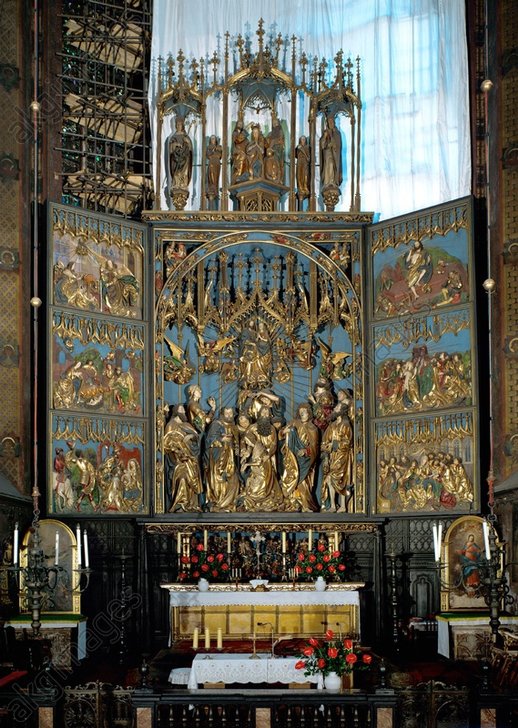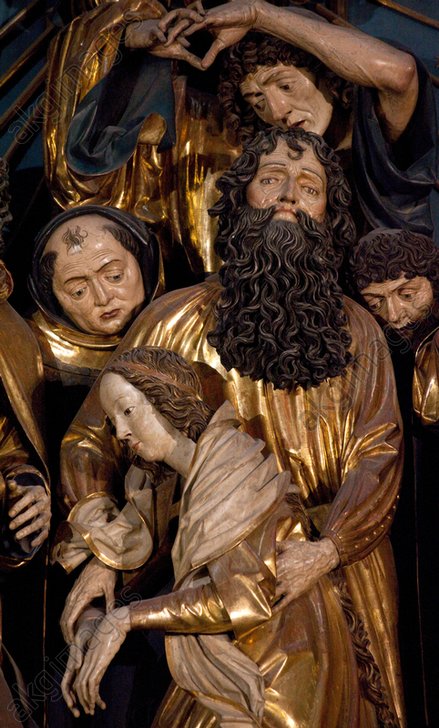Worshipping at the Altar

© akg-images / Erich Lessing
Earlier this month I was in Poland to attend the annual Cepic conference which this year was held in Warsaw. My first visit to Poland was eighteen years ago when, as part of a summer tour, the choir in which I was singing travelled to Kraków and performed in St. Mary’s Basilica, the fourteenth-century Gothic church next to the main market square. My strongest memory of Kraków is of being overwhelmed by Veit Stoss’s astonishing winged altarpiece, thirteen metres high and eleven metres wide when fully opened, the pride of the basilica and one of the great masterpieces of late Gothic art.

© akg-images / Schütze / Rodemann
It’s not just the size of the altarpiece that is so overwhelming, it’s the artistry of the work itself. Rather than being made up of painted panels, the altarpiece is fully carved. We sang in the church to mark one of the major feast days in the calendar, so the wings of the altarpiece were opened out, so that the awe-inspiring central panel showing the death of the Virgin Mary with its polychrome figures and exquisite gilding was visible.

© akg-images / Bildarchiv Monheim
In a break from the Cepic conference, I escaped the June heat by visiting the National Museum in Warsaw. The museum’s Gallery of Medieval Art has recently been redeveloped and is extraordinarily beautiful. The walls are dark grey, the lighting very carefully designed to feel like the interior of a church. On display are works from the late Middle Ages to the Early Renaissance, focussing on art from what is now Poland, of course, but there are also some extraordinary painted panels and sculptures from across Northern Europe. I found the museum’s collection of polychrome Gothic altarpieces particularly moving and the highlight of the museum trip for me.

© akg-images / Erich Lessing
I know that for many people, medieval and Gothic art from northern Europe can be too stark, its saints too po-faced and the backgrounds too flat and gilded, but I am continually surprised by the humanity and artistry of these works and it made me wonder why their artists are not more widely celebrated. Some artists’ names have been lost to history, of course, and are known only to us as the “Master of Such-and-Such“, but talents like Veit Stoss, Michael Pacher and Tilman Riemenschneider deserve to be as highly regarded as Michelangelo or Donatello.

© akg-images / Bildarchiv Monheim
Polychrome sculpture did not begin and end with the Northern Middle Ages of course: we know now that ancient Greek sculptures were originally brightly painted, and the National Gallery’s 2010 exhibition on seventeenth-century Spanish religious sculpture was enlightening and fascinating, even if some of the highly lifelike sculptures were a little creepy! Marie Toussaud’s wax sculptures of French Revolutionary figures gave birth to a global tourist attraction, and artists like Duane Hanson make hyperreal sculptures of everyday people. But there is something in those early altarpiece figures, with their detailed clothing and beatific faces, that particularly appeals to me. I would urge everyone to look again at these sculptures: walking through Warsaw’s National Museum, I understood the religious power and significance these artworks had, even though centuries had passed since they were created and they were no longer in the churches for which they were carved. I have been through the akg archive and selected some of my favourites from a variety of photographers and agencies which you can view over on our website.

© akg-images / Bildarchiv Steffens